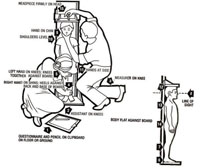5.2.2 Height
This is measured with the child or adult in a standing position (usually children who are two years old or more). The head should be in the Frankfurt position (a position where the line passing from the external ear hole to the lower eye lid is parallel to the floor) during measurement, and the shoulders, buttocks and the heels should touch the vertical stand. Either a stadiometer or a portable anthropometer can be used for measuring. Measurements are recorded to the nearest millimetre.
Procedure
As with measuring a child’s length, to measure a child’s height, you need to have another person helping you. Figure 5.2 illustrates the procedures, and in Figure 5.3 you can see a young child having his height measured.
- Both the assistant and measurer should be on their knees (arrows 2 and 3).
- The right hand of the assistant should be on the shins of the child against the base of the board (arrow 4).
- The left hand of the assistant should be on the knees of the child to keep them close to the board (arrow 5).
- The heel, the calf, buttocks, shoulder and occipital prominence (prominent area on the back of the head) should be flat against the board (arrows 6, 7, 14, 13 and 12).
- The child should be looking straight ahead (arrow 8).
- The hands of the child should be by their side (arrow 11).
- The measurer’s left hand should be on the child’s chin (arrow 9).
- The child’s shoulders should be levelled (arrow 10).
- The head piece should be placed firmly on the child’s head (arrow 15).
- The measurement should be recorded on the questionnaire (arrow 1).
5.2.1 Length

